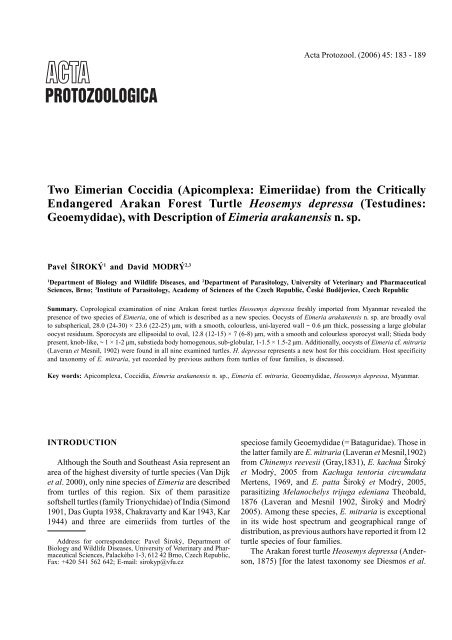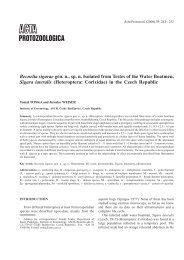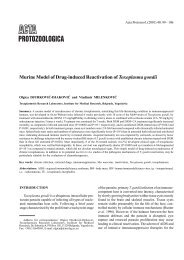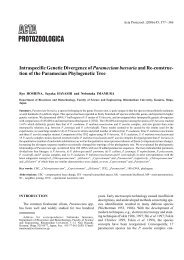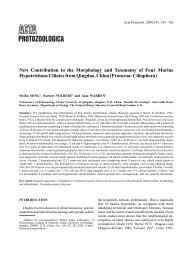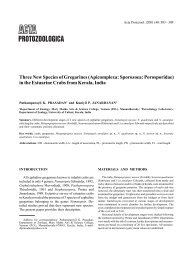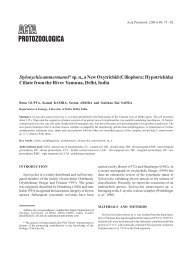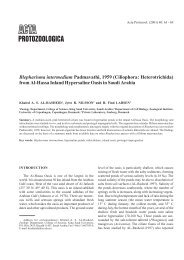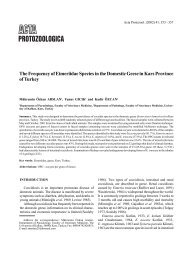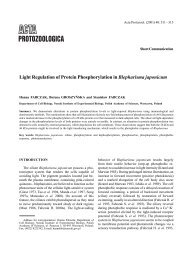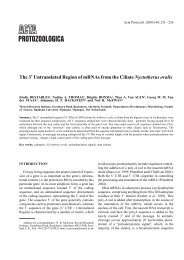Two Eimerian Coccidia (Apicomplexa: Eimeriidae) from the Critically ...
Two Eimerian Coccidia (Apicomplexa: Eimeriidae) from the Critically ...
Two Eimerian Coccidia (Apicomplexa: Eimeriidae) from the Critically ...
- No tags were found...
Create successful ePaper yourself
Turn your PDF publications into a flip-book with our unique Google optimized e-Paper software.
Acta Protozool. (2006) 45: 183 - 189<strong>Two</strong> <strong>Eimerian</strong> <strong>Coccidia</strong> (<strong>Apicomplexa</strong>: <strong>Eimeriidae</strong>) <strong>from</strong> <strong>the</strong> <strong>Critically</strong>Endangered Arakan Forest Turtle Heosemys depressa (Testudines:Geoemydidae), with Description of Eimeria arakanensis n. sp.Pavel ŠIROKÝ 1 and David MODRÝ 2,31Department of Biology and Wildlife Diseases, and 2 Department of Parasitology, University of Veterinary and PharmaceuticalSciences, Brno; 3 Institute of Parasitology, Academy of Sciences of <strong>the</strong> Czech Republic, Èeské Budìjovice, Czech RepublicSummary. Coprological examination of nine Arakan forest turtles Heosemys depressa freshly imported <strong>from</strong> Myanmar revealed <strong>the</strong>presence of two species of Eimeria, one of which is described as a new species. Oocysts of Eimeria arakanensis n. sp. are broadly ovalto subspherical, 28.0 (24-30) × 23.6 (22-25) µm, with a smooth, colourless, uni-layered wall ~ 0.6 µm thick, possessing a large globularoocyst residuum. Sporocysts are ellipsoidal to oval, 12.8 (12-15) × 7 (6-8) µm, with a smooth and colourless sporocyst wall; Stieda bodypresent, knob-like, ~ 1 × 1-2 µm, substieda body homogenous, sub-globular, 1-1.5 × 1.5-2 µm. Additionally, oocysts of Eimeria cf. mitraria(Laveran et Mesnil, 1902) were found in all nine examined turtles. H. depressa represents a new host for this coccidium. Host specificityand taxonomy of E. mitraria, yet recorded by previous authors <strong>from</strong> turtles of four families, is discussed.Key words: <strong>Apicomplexa</strong>, <strong>Coccidia</strong>, Eimeria arakanensis n. sp., Eimeria cf. mitraria, Geoemydidae, Heosemys depressa, Myanmar.INTRODUCTIONAlthough <strong>the</strong> South and Sou<strong>the</strong>ast Asia represent anarea of <strong>the</strong> highest diversity of turtle species (Van Dijket al. 2000), only nine species of Eimeria are described<strong>from</strong> turtles of this region. Six of <strong>the</strong>m parasitizesoftshell turtles (family Trionychidae) of India (Simond1901, Das Gupta 1938, Chakravarty and Kar 1943, Kar1944) and three are eimeriids <strong>from</strong> turtles of <strong>the</strong>Address for correspondence: Pavel Široký, Department ofBiology and Wildlife Diseases, University of Veterinary and PharmaceuticalSciences, Palackého 1-3, 612 42 Brno, Czech Republic,Fax: +420 541 562 642; E-mail: sirokyp@vfu.czspeciose family Geoemydidae (= Bataguridae). Those in<strong>the</strong> latter family are E. mitraria (Laveran et Mesnil,1902)<strong>from</strong> Chinemys reevesii (Gray,1831), E. kachua Širokýet Modrý, 2005 <strong>from</strong> Kachuga tentoria circumdataMertens, 1969, and E. patta Široký et Modrý, 2005,parasitizing Melanochelys trijuga edeniana Theobald,1876 (Laveran and Mesnil 1902, Široký and Modrý2005). Among <strong>the</strong>se species, E. mitraria is exceptionalin its wide host spectrum and geographical range ofdistribution, as previous authors have reported it <strong>from</strong> 12turtle species of four families.The Arakan forest turtle Heosemys depressa (Anderson,1875) [for <strong>the</strong> latest taxonomy see Diesmos et al.
184 P. Široký and D. Modrý(2005)], is endemic to Myanmar (formerly Burma) (WinMaung and Win Ko Ko 2002), and belongs to <strong>the</strong> rarestturtles of <strong>the</strong> world (Iverson and McCord 1997), andthan being listed as critically endangered (IUCN 2004).Recently, we had a chance to examine nine specimensof H. depressa, freshly imported <strong>from</strong> western Myanmar.<strong>Two</strong> species of Eimeria were found to parasitize thisturtle, one of which is described in this paper as new.MATERIALS AND METHODSNine Arakan forest turtles, H. depressa, were imported into <strong>the</strong>Czech Republic <strong>from</strong> China and are currently kept alive in a privatecollection. Originally, <strong>the</strong>se animals were exported by a Chinese petanimal dealer <strong>from</strong> western Myanmar to China in August 2003. Basedon <strong>the</strong> dealer’s information all specimens were freshly caught in <strong>the</strong>wild, which corresponds with observed ticks’ infestation and perfectstate of health of <strong>the</strong> animals. Despite this fact, exact locality of <strong>the</strong>irorigin was not given.During quarantine, turtles were housed separately in plastic boxes.Individually collected fresh faeces were placed in 2.5% aqueous (w/v)potassium dichromate (K 2Cr 2O 7), mixed thoroughly, and <strong>the</strong>n allowedto sporulate in open shallow plastic containers at 20-23°C.Samples were examined after concentration by flotation using amodified Shea<strong>the</strong>r’s sugar solution (specific gravity 1.3). Oocystswere measured and photographed using an Olympus Provis AX 70microscope equipped with Nomarski interference contrast optics(NIC). Morphological features were described according to Duszynskiand Wilber (1997), and measurements were made on 30 oocysts usinga calibrated ocular micrometer and are reported in micrometers (µm)as means, followed by ranges in paren<strong>the</strong>ses.RESULTSCoprological examination revealed eggs of undeterminednematodes and <strong>the</strong> presence of oocysts of twoeimerians. Three H. depressa were infected with a thusfar undescribed Eimeria species; all nine harboured <strong>the</strong>oocysts of Eimeria cf. mitraria (Laveran et Mesnil,1902). Moreover, two ticks of <strong>the</strong> genus Amblyommawere found on a single turtle during <strong>the</strong> initial inspection.Eimeria arakanensis n. sp. (Figs 1-3, 7)Description of oocysts: Oocysts are broadly oval tosub-spherical, 28.0 (24-30) × 23.6 (22-25), oocyst shapeindex (SI, length/width) 1.19 (1.08-1.36), oocyst wallFigs 1-3. Nomarski interference contrast photographs of oocysts of Eimeria arakanensis n. sp., all in <strong>the</strong> same scale. 1 - sporulated oocyst,note large oocyst residuum (arrowhead) and subglobular substieda body (arrow). Scale bar: 10 µm; 2 - sporocysts in collapsed oocyst, noterefractile body (arrowhead); 3 - sporulated oocyst <strong>from</strong> a polar view, note membranous cupola-like structure covering <strong>the</strong> Stieda body(arrowhead).Figs 4-6. Nomarski interference contrast photographs of oocysts of Eimeria cf. mitraria (Laveran et Mesnil, 1902), all in <strong>the</strong> same scale.4 - sporulated oocyst, note <strong>the</strong> Stieda body (arrowhead). Scale bar: 10 µm; 5 - sporocysts tightly packed in sporulated oocyst, prominentrefractile body is marked by arrowhead; 6 - overall shape of sporulated oocyst with distinct projections.
<strong>Two</strong> Eimeria spp. <strong>from</strong> Heosemys depressa 185Fig. 7. Composite line drawing of sporulated oocyst of Eimeriaarakanensis n. sp. Scale bar: 10 µm.single-layered, colourless, smooth and ~ 0.6 thick. Micropyleand polar granule absent. Globular oocyst residuumcomposed of fine granules present, measuringapproximately 10 - 15 in diameter. Sporocysts ellipsoidalto oval, 12.8 (12-15) × 7 (6-8), sporocyst SI 1.84 (1.63-2.17), with smooth, colourless and less than 0.5 thicksporocyst wall. Stieda body present, knob-like, ~ 1 highand 1-2 wide (n = 12). Substieda body homogenous, subglobular,1-1.5 high and 1.5-2 wide (n = 12). Very thin,membranous, cap-like structure over-layering Stieda body.Sporocyst residuum present as small granules of irregularsizes usually scattered in high number among sporozoites.Sporozoites elongate, cucumber-shaped, lyinghead to tail within sporocyst. Each sporozoite bears onesub-spherical to spherical refractile body (~1-2 × 1.5-2)at one end, smaller nucleus (~1-2 in diameter) locatedsub-centrally.Type host: Arakan forest turtle, Heosemys depressa(Anderson, 1875) (Reptilia: Testudines: Geoemydidae).Type material: Photosyntypes are deposited at <strong>the</strong>Department of Parasitology, University of Veterinaryand Pharmaceutical Sciences Brno, Czech Republic,under collection number R 100/05.Type locality: Western Myanmar (Burma), detailedlocality unknown.Prevalence: Three of nine examined specimens ofH. depressa were infected.Sporulation: Exogenous. Oocyst became fully sporulatedwithin 3-5 days at 20-23°C.Table 1. Review of turtle species reported to date as hosts of Eimeria mitraria (Laveran et Mesnil, 1902), asterisk marks <strong>the</strong> type host.Host Locality Size of oocysts ReferencesGeoemydidae Theobald, 1868Chinemys reevesii (Gray, 1831)* Asia 15 × 10 Laveran and Mesnil (1902)Heosemys depressa (Anderson, 1875) Myanmar 14.9 × 10.1 This studyEmydidae Rafinesque, 1815Chrysemys picta bellii (Gray, 1831) Iowa (USA) 10-15 × 5-11 Deeds and Jahn (1939)Iowa (USA) 10 × 7.6 Wacha and Christiansen (1976)Emydoidea blandingii (Holbrook, 1838) Iowa (USA) Not given Wacha and Christiansen (1980)Emys orbicularis (Linnaeus, 1758) Galicia (Spain) 12.1 × 9.5 (10-14 × 7-11) Segade et al. (2004)Graptemys geographica (Le Seur, 1817) Iowa (USA) 11 × 8.3 Wacha and Christiansen (1976)Graptemys pseudogeographica (Gray, 1831) Iowa (USA) 9.2 × 8.1 Wacha and Christiansen (1976)Graptemys versa Stejneger, 1925 Texas (USA) Not given McAllister et al. (1991)Pseudemys texana Baur, 1893 10 × 8 (8-12 × 6-9) McAllister and Upton (1989)Trachemys scripta elegans (Wied-Neuwied, 1839) Texas (USA) Not given McAllister and Upton (1988)10 × 8 (8-12 × 6-9) McAllister and Upton (1989)Chelydridae Agassiz, 1857Chelydra serpentina serpentina (Linnaeus, 1758) Iowa (USA) Not given Wacha and Christiansen (1980)Kinosternidae Agassiz, 1857Kinosternon flavescens flavescens (Agassiz, 1857) Texas (USA) 10 × 8 (8-12 × 6-9) McAllister and Upton (1989)Kinosternon flavescens spooneri Smith, 1951 Iowa (USA) 11.5 × 8.6 Wacha and Christiansen (1976)
186 P. Široký and D. ModrýFigs 8-11. Comparison of E. mitraria <strong>from</strong> H. depressa with drawings <strong>from</strong> previous studies. 8 - composite line drawing of our isolates ofE. mitraria. Scale bar: 10 µm. 9 - E. mitraria <strong>from</strong> original description (Laveran and Mesnil 1902). 10 - E. mitraria <strong>from</strong> nearctic turtle species(modified after Wacha and Christiansen 1976). 11 - process of sporulation of E. mitraria <strong>from</strong> Chrysemys picta bellii (after Deeds and Jahn1939).Site of infection: Unknown, collected <strong>from</strong> faeces.Etymology: The specific epi<strong>the</strong>t arakanensis isderived <strong>from</strong> <strong>the</strong> name of Arakan hills, <strong>the</strong> “terra typica”of <strong>the</strong> type host.Remarks: Eimeria brodeni Cerruti, 1930 described<strong>from</strong> Testudo graeca Linnaeus, 1758 <strong>from</strong> Cagliari,Sardinia, Italy is <strong>the</strong> only Eimeria <strong>from</strong> turtles of <strong>the</strong>Testudinoidea that resembles Eimeria arakanensis n.sp. morphologically. However, oocysts of E. brodeni arenarrower and lack an oocyst residuum (Cerruti 1930).E. chrysemydis Deeds et Jahn, 1939 <strong>from</strong> Chrysemyspicta bellii (Gray, 1831) <strong>from</strong> Iowa, USA possessesoocysts of similar size, but are pear-shaped (Deeds andJahn 1939) compared to broadly oval of E. arakanensisn. sp. All o<strong>the</strong>r coccidian species <strong>from</strong> testudinoid hostsare significantly smaller.Eimeria cf. mitraria (Laveran et Mesnil, 1902)(Figs 4-6, 8-11)Description of oocysts: Oocysts ovoid, 14.9(13-16) × 10.1 (9-12); SI is 1.48 (1.27-1.78); micropyle,polar granule and oocyst residuum absent. Oocyst wallsmooth, colourless, under light microscopy single-layered,~ 0.5 thick. Each pole of oocyst bears blunt conicalprojections, ~ 1.2 (1-1.5) long. Most oocysts possessthree projections on one (“flat”) pole, and one on <strong>the</strong>opposite (“conical”) end, giving <strong>the</strong> oocyst projectile-likeappearance. Never<strong>the</strong>less, specimens with two andthree projections were rarely seen. Sporocysts oval toellipsoidal, 6.8 (6-8) × 4.2 (3.5-5), with smooth andcolourless sporocyst wall and sporocyst SI 1.64 (1.3-2).Stieda body present as tiny knob-like projection. Substieda
<strong>Two</strong> Eimeria spp. <strong>from</strong> Heosemys depressa 187Figs 12A-D. Schematic drawings of morphological types of oocystsof Eimeria spp. described <strong>from</strong> turtles. A - oocysts of various shapepossessing distinct oocyst residuum, B - elliptical, sub-spherical tospherical oocysts lacking oocyst residuum; C - thin-walled oocystswith shape influenced by position of sporocysts inside, and lackingoocyst residuum; D - mitra-shaped (Eimeria mitraria - like) oocystswithout oocyst residuum.body not discernible. Sporozoites elongate, arrangedhead to tail within sporocyst. Each sporozoite bears aprominent spherical to sub-spherical refractile body(~ 2-3 × 2) at one end, nucleus not discernible. Sporocystresiduum present, usually as compact granular sphere,~ 2-3 in diameter.DISCUSSION<strong>Eimerian</strong> parasites are traditionally considered to behighly host specific (Duszynski 1986) and host systematicsand geographic origin are common tools in <strong>the</strong>irtaxonomy. However, strict host specificity of Eimeriaspp. parasitizing reptiles was repeatedly questioned (i.e.Wacha and Christiansen 1974, 1976; McAllister andUpton 1989). Thus, Eimeria spp. described and named<strong>from</strong> turtles of families Emydidae, Geoemydidae, andTestudinidae [superfamily Testudinoidea sensu Gaffneyand Meylan (1988)] are considered in <strong>the</strong> differentialdiagnosis of E. arakanensis n. sp. given above.Genus Eimeria represents <strong>the</strong> most specious genuswithin both protozoan and metazoan organisms. Untilrecently, more than 1700 named Eimeria species havebeen described on <strong>the</strong> base of <strong>the</strong> qualitative and quantitativetraits of <strong>the</strong>ir sporulated oocyst and <strong>the</strong>ir hostspecificity (Duszynski and Upton 2001). Despite <strong>the</strong>great oocyst variability, <strong>the</strong>re is an evident trend ofrepetition of typical morphological features in Eimeriaspecies, originating <strong>from</strong> different hosts <strong>from</strong> differentzoogeographic regions. Thorough evaluation of oocystmorphology reveals many such “morphotypes”. Eimerialeukarti Reichenow, 1940 <strong>from</strong> horses and E. cameliReichenow, 1952 <strong>from</strong> dromedaries can be used as amost prominent example of such similarity. Recent studieson rodent and bat Eimeria species revealed thatsome morphological features (namely <strong>the</strong> presence of<strong>the</strong> oocysts residuum) show a clear correlation to <strong>the</strong>phylogenetic relationships as determined by <strong>the</strong> moleculargenetic methods (Zhao and Duszynski 2001a,b; Zhaoet al. 2001). It is probable, that fur<strong>the</strong>r studies revealphylogenies, showing even more such “subgroups” withinevidently polyphyletic genus Eimeria.Also among chelonian Eimeria, <strong>the</strong> oocyst shapeand absence vs. presence of <strong>the</strong> oocyst residuum canbe used to group species toge<strong>the</strong>r (Fig. 12). Howsoeverarbitrary such a grouping looks like, above-mentionedcase of rodent coccidia suggests <strong>the</strong> evolutionarily significanceof some aspects of <strong>the</strong> oocyst morphology.Then, <strong>the</strong> following morphological types can be delimitedwithin chelonian Eimeria: (a) species with oocystsof various shape possessing an oocyst residuum, i.e.E. chrysemydis Deeds et Jahn, 1939; E. cooteriMcAllister et Upton, 1989; E. delagei (Labbé, 1893);E. kachua Široký et Modrý, 2005; E. marginata Deedset Jahn, 1939; (b) species with elliptical, sub-spherical tospherical oocyst without <strong>the</strong> oocyst residuum(E. geochelona Couch, Stone, Duszynski, Snell et Snell,1996; E. koormae Das Gupta, 1938; E. mascoutiniWacha et Christiansen, 1976; E. paynei Ernst, Fincheret Stewart, 1971; E. serpentina McAllister, Upton etTrauth, 1990); (c) Eimeria spp. with peculiar thin walledoocysts of polymorphic shape without oocyst residuum(E. motelo Hùrková, Modrý, Koudela et Šlapeta, 2000;E. patta Široký et Modrý, 2005); and, (d) species withEimeria mitraria-like oocysts, which also lack oocystresiduum and typically possess peculiar projections of<strong>the</strong> oocyst wall [E. mitraria (Laveran et Mesnil, 1902);E. stylosa, McAllister et Upton, 1989]. At least <strong>the</strong> lattercase is probably a case of synapomorphy ra<strong>the</strong>r thanconvergence and it is possible, that actually each of<strong>the</strong>se morphologically defined groups represent a separateevolutionary lineage, emergence of which predates<strong>the</strong> separation of continents.
188 P. Široký and D. ModrýChelonians of Eurasian and American continentshave been geographically separated since <strong>the</strong> middleMiocene (Danilov 2005). Originally, E. mitraria wasdescribed <strong>from</strong> Chinemys reevesii <strong>from</strong> SE Asia. Laterauthors considered fur<strong>the</strong>r eimerian isolates <strong>from</strong>10 Nearctic turtle taxa of o<strong>the</strong>r three families (includingphylogeneticaly distant families Chelydridae andKinosternidae) to be conspecific with E. mitraria(Table 1, Figs 8-11). Moreover, we currently foundmorphologically very similar oocysts in Neotropical chelidturtle Batrachemys heliostemma McCord, Joseph-Ouniet Lamar, 2001 <strong>from</strong> Peru (data not shown).It is hard to imagine that protozoan with a shortgeneration intervals can survive for 15 millions yearswithout fur<strong>the</strong>r speciation. Thus, wide occurrence ofE. mitraria in hosts of two suborders in two distantcontinents makes <strong>the</strong> conspecificity of isolates ra<strong>the</strong>rimprobable. Moreover, all E. mitraria-like coccidia reportedto date <strong>from</strong> Nearctic turtles have smaller oocysts(Table 1) comparing to <strong>the</strong> size given forE. mitraria by Laveran and Mesnil (1902). We believethat mitra-shaped oocysts reported to date <strong>from</strong> 13 turtlehosts (McAllister and Upton 1989, Lainson and Naiff1998, Segade et al. 2004) is a common, synapomorphictrait of Eimeria <strong>from</strong> aquatic turtles. Thus, E. mitraria,as presently used, possibly represents a “morphotype”ra<strong>the</strong>r than a species. Similar cases can be found incoccidia of o<strong>the</strong>r hosts; i.e. Eimeria callospermophyliHenry, 1932 is reported <strong>from</strong> both Palaearctic andNearctic ground squirrels (Wilber et al. 1998).So far, a universal species concept is not evendiscussed in <strong>the</strong> area of coccidian taxonomy and variablecombination of morphological, biological and evolutionaryspecies concepts is used throughout <strong>the</strong> taxonomicalstudies by various authors. Such a discouraging situationcalls for intense research and broad, interdisciplinarydiscussion aimed to provide a species concept adequateto <strong>the</strong> current state of knowledge.Acknowledgements. We are indebted to Olympus C&S for generoustechnical support. We thank Petr Petrás and Hynek Prokop,for cooperation with sampling of <strong>the</strong>ir animals. Current systematicposition of H. depressa was discussed with Uwe Fritz. Additionalinformation about <strong>the</strong> eimerian coccidia of reptiles can be found athttp://biology.unm.edu/biology/coccidia/home.html. This study wassupported by <strong>the</strong> grant 524/03/D104 of <strong>the</strong> Grant Agency of <strong>the</strong>Czech Republic.REFERENCESCerruti C. (1930) Su di un coccidio parassita di Testudo graeca Linn.Arch. Ital. Sci. Med. Col. 11: 328-331Chakravarty M., Kar A. B. (1943) Observations on two coccidia,Eimeria trionyxae n. sp. and Eimeria triangularis n. sp., <strong>from</strong> <strong>the</strong>intestine of <strong>the</strong> turtle Trionyx gangeticus Cuv. J. R. Asiat. Soc.Bengal Sci. 9: 49-54Danilov I. G. (2005) Die fossilen Schildkröten Europas. In: Handbuchder Reptilien und Amphibien Europas. Schildkröten (Testudines)II, (Ed. U. Fritz). AULA-Verlag GmbH, Wiebelsheim, Germany,329-441Das Gupta M. (1938) On a new coccidium, Eimeria koormae n. sp.<strong>from</strong> <strong>the</strong> intestine of <strong>the</strong> Indian tortoise, Lissemys punctata Smith.Arch. Protistenk. 90: 410-413Deeds O. J., Jahn T. L. (1939) <strong>Coccidia</strong>n infections of westernpainted turtles of <strong>the</strong> Okoboji region. Trans. Am. Micr. Soc. 58:249-253Diesmos A. C., Parham J. F., Stuart B. L., Brown R. M. (2005) Thephylogenetic position of <strong>the</strong> recently rediscovered Philippineforest turtle (Bataguridae: Heosemys leytensis). Proc. Calif. Acad.Sci. 56: 31-41Duszynski D. W. (1986) Host specificity in <strong>the</strong> coccidia of smallmammals: Fact or fiction? In: Advances in Protozoological Research,(Ed. M. Berecky). Symposia Biologica Hungarica,Akadémiai Kiadó, Budapest, Hungary, 33: 325-337Duszynski D. W., Upton S. J. (2001) The common coccidia of wildmammals. Cyclospora, Eimeria (<strong>Eimeriidae</strong>) and Cryptosporidium(Cryptosporidiidae) spp. In: Parasitic Diseases of Wild Mammals,(Eds. W. M. Samuel, M. J. Pybus, A. A. Kocan). Iowa StateUniversity Press, Ames, IA, 416-433Duszynski D. W., Wilber P. G. (1997) A guideline for <strong>the</strong> preparationof species descriptions in <strong>the</strong> <strong>Eimeriidae</strong>. J. Parasitol. 83: 333-336Gaffney, E. S., Meylan, P. A. (1988) A phylogeny of turtles. In: ThePhylogeny and Classification of <strong>the</strong> Tetrapods. Amphibians,Reptiles, Birds (Ed. M. J. Benton). Oxford (Clarendon Press), 1:157-219IUCN (2004) 2004 IUCN Red List of Threatened Species.www.redlist.orgIverson J. B., McCord W. P. (1997) Redescription of <strong>the</strong> ArakanForest Turtle Geoemyda depressa Anderson 1875 (Testudines:Bataguridae). Chelonian Conserv. Biol. 2: 384-389Kar A. B. (1944) <strong>Two</strong> new coccidia <strong>from</strong> pond turtles, Lissemyspunctata (Bonnaterre). Indian Vet. J. 20: 231-234Lainson R., Naiff R. D. (1998) Eimeria peltocephali n. sp.,(<strong>Apicomplexa</strong>: <strong>Eimeriidae</strong>) <strong>from</strong> <strong>the</strong> Freshwater TurtlePeltocephalus dumerilianus (Chelonia: Pelomusidae) and Eimeriamolossi n. sp., <strong>from</strong> <strong>the</strong> Bat, Molossus ater (Mammalia:Chiroptera). Mem. Inst. Oswaldo Cruz 93: 81-90Laveran A., Mesnil F. (1902) Sur quelques protozoaires parasitesd’une tortue d’Asie (Damonia reevesii). C. r. Séanc. Acad. Sci.Ser. 3 135: 609-614McAllister C. T., Upton S. J. (1988) Eimeria trachemydis n. sp.(<strong>Apicomplexa</strong>: <strong>Eimeriidae</strong>) and o<strong>the</strong>r eimerians <strong>from</strong> <strong>the</strong> Redearedslider, Trachemys scripta elegans (Reptilia: Testudines), innorthcentral Texas. J. Parasitol. 74: 1014-1017McAllister C. T., Upton S. J. (1989) The <strong>Coccidia</strong> (<strong>Apicomplexa</strong>:<strong>Eimeriidae</strong>) of Testudines, with descriptions of three new species.Can. J. Zool. 67: 2459-2467McAllister C. T., Upton S. J., Killebrew F. C. (1991) <strong>Coccidia</strong>nparasites (<strong>Apicomplexa</strong>: <strong>Eimeriidae</strong>) of Graptemys caglei andGraptemys versa (Testudines: Emydidae) <strong>from</strong> Texas. J. Parasitol.77: 500-502Segade P., Ayres C., Cordero A., Crespo-Gonzáles C., García-Estévez J. M., Iglesias R. (2004) Intestinal coccidia <strong>from</strong> <strong>the</strong>European pond turtle, Emys orbicularis, in Galicia (NW Spain).In: IX. European Multicolloquium of Parasitology, Valencia,Spain, 18-23 July 2004. Programme and Abstracts, (Eds. S. Mas-Coma, M. D. Bargues, J. G. Esteban, M. A. Valero) 584Simond P.-L. (1901) Note sur une coccidie nouvelle, CoccidiumLegeri, parasite de Cryptopus granosus (Emyda granosa). C. r.Séanc. Soc. Biol. (Paris) 53: 485-486Široký P., Modrý D. (2005) <strong>Two</strong> new species of Eimeria(<strong>Apicomplexa</strong>: <strong>Eimeriidae</strong>) <strong>from</strong> Asian geoemydid turtles Kachuga
<strong>Two</strong> Eimeria spp. <strong>from</strong> Heosemys depressa 189tentoria and Melanochelys trijuga (Testudines: Geoemydidae).Parasite 12: 9-13Van Dijk P. P., Stuart B. L., Rhodin A. G. J. (Eds.) (2000) Asian TurtleTrade. Proceedings of a workshop on conservation and trade offreshwater turtles and tortoises in Asia, Phnom Penh, Cambodia,1-4 December 1999. Chelonian Research Monographs 2. ChelonianResearch Foundation, Lunenburg, MAWacha R. S., Christiansen J. L. (1974) Systematics of <strong>the</strong> <strong>Eimerian</strong>parasites <strong>from</strong> North American snakes of <strong>the</strong> family Colubridae,and <strong>the</strong>ir prevalence in <strong>the</strong> Colubrids of Iowa. J. Protozool. 21:483-489Wacha R. S., Christiansen J. L. (1976) <strong>Coccidia</strong>n parasites <strong>from</strong> Iowaturtles: Systematics and prevalence. J. Protozool. 23: 57-63Wacha R. S., Christiansen J. L. (1980) <strong>Coccidia</strong>n parasites <strong>from</strong> Iowaturtles. J. Protozool. 27: 28A-29AWin Maung, Win Ko Ko (2002) Turtles & Tortoises of Myanmar.Wildlife Conservation Society, Yangon, Union of MyanmarWilber P. G., Duszynski D. W., Upton S. J., Seville R. S., Corliss J.O. (1998) A revision of <strong>the</strong> taxonomy and nomenclature of <strong>the</strong>Eimeria spp. (<strong>Apicomplexa</strong>: <strong>Eimeriidae</strong>) <strong>from</strong> rodents in <strong>the</strong>Tribe Marmotini (Sciuridae). Syst. Parasitol. 39: 113-135Zhao X., Duszynski D. W. (2001a) Molecular phylogenies suggest<strong>the</strong> oocyst residuum can be used to distinguish two independentlineages of Eimeria spp in rodents. Parasitol. Res. 87: 638-643Zhao X., Duszynski D. W. (2001b) Phylogenetic relationshipsamong rodent Eimeria species determined by plastid ORF470and nuclear 18S rDNA sequences. Int. J. Parasitol. 31: 715-719Zhao X., Duszynski D. W., Loker E. S. (2001) Phylogenetic positionof Eimeria antrozoi, a bat coccidium (<strong>Apicomplexa</strong>: <strong>Eimeriidae</strong>)and its relationships to morphologically similar Eimeria spp.<strong>from</strong> bats and rodents based on nuclear 18S and plastid 23S rDNAsequences. J. Parasitol. 87: 1120-1123Received on 20th September, 2005; revised version on 20th January,2006; accepted on 10th February, 2006


